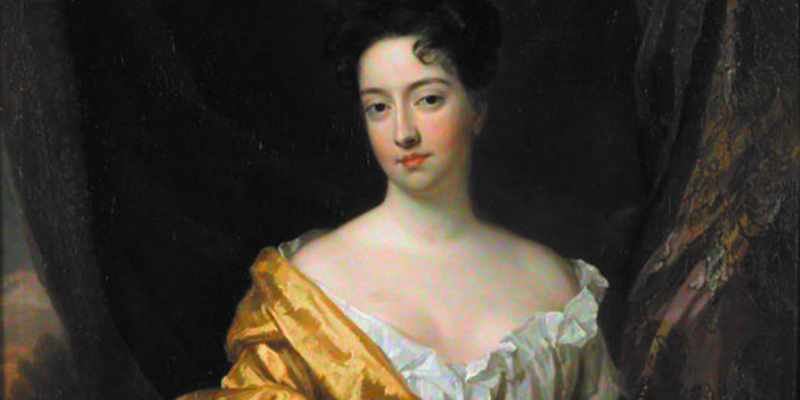In a completely fictional world, characters can be designed to suit your plot. But in my historical fiction (the Hunt & Hooke novels, published by Melville House Publishing) I use real people and real events of the 1670s and 1680s, mixing them with made-up stuff. I’m very lucky that one real person, who happened to live where and when my books are set, was the scandalous, outrageous, and transgressive Ortensio (Hortense) Mancini, Duchesse de Mazarin (1646 – 1699). No amount of designing could surpass her.
Her father, Baron Lorenzo Mancini, was a Roman aristocrat—the Mancini family traces its lineage back to the time of Romulus—and an astrologer and necromancer, none of which stopped him dying young. Newly widowed, their mother, Girolama Mazarini, took her five daughters (Hortense was the fourth) and three sons to Paris to benefit from her brother’s influence. As its chief minister, Cardinal Mazarin effectively ruled France, and accrued a huge fortune doing so.
Charles II proposed to Hortense, but timed it badly: a year before his Restoration, he was still in exile. The Cardinal rejected him, but changed his mind when Charles became King of England Even though Mazarin offered a dowry of 5 million livres*, Charles refused. His refusal was partly because of advice from his courtiers, anxious to avoid undue interference from France—little did they know—and also because of his pride.
The following year, fourteen-year-old Hortense was married to—note, not just ‘married’–the Duc de La Meilleraye instead. He was one of the richest men in Europe, if not the richest. He was granted the title of duc de Mazarin, so Hortense became the duchesse de Mazarin. When her uncle died, he gained access to his wife’s huge inheritance. Sadly, after this promising start to their marriage, the duc’s behaviour became very odd. He had his female servants’ teeth knocked out to make them less distracting, forbade his milkmaids from milking—too sexual, apparently—and censored his art collection, damaging it by doing so; genitals were beyond the pale. If he had only left it there, Hortense could probably have tolerated him, but he insisted she spend most of her day at prayer, avoid all other men, and he moved her from Paris to the countryside.
After seven years of this, Hortense made her escape. Leaving her young children (astonishing that they had children, I know), with her brother’s help, she travelled to Rome, taking refuge with her sister, Marie, who was now the Princess Colonna. She, also, had an abusive husband—she feared he might kill her. Their memoirs, published together, detail what they suffered. The two women then escaped to France together.
Louis XIV, who had loved Marie before her marriage, helped them by granting them pensions. Hortense set up home in Chambéry. This became a ‘salon’, a meeting place for authors, philosophers, and artists. Unfortunately, her husband went to law and managed to freeze her income, so, hoping for help from Charles II, Hortense travelled to London. To do so, she apparently disguised herself as a man, perhaps only because male clothing was more comfortable and practical. There have been some very ‘modern’ interpretations of her choice of clothing. It was seen as transgressive then; she certainly anticipated the impact it caused.
Very shortly, Hortense became Charles II’s mistress. (Of course she did). He provided her with a generous pension and a house—her ‘petit palais’—in St. James’s Park. But she either overplayed her hand or chose to alienate him. She embarked on a relationship with one of his illegitimate daughters—Charles had several—Anne, the Countess of Sussex. Famously, the women conducted a fencing match in St. James’s Park; to spice up the spectacle both dressed in their nightgowns. After this scandal Anne’s husband removed his wife from London. Supposedly, Anne pined terribly for her lover, repeatedly kissing a painted miniature of her. (I take this to be a small painting rather than a tiny doll.)
Then Hortense took up with the Prince de Monaco, Louis I de Grimaldi. The King angrily stopped her pension, although soon he changed his mind But this was the end of Hortense’s position as the king’s favourite.
Aphra Behn, author and dramatist, also seems to have had a relationship with Hortense. The introduction to her The History of the Nun includes the words how infinitely one of Your own Sex ador’d You, and that, among all the numerous Conquest, Your Grace has made over the Hearts of Men, Your Grace had not subdu’d a more intire Slave … And how few Objects are there, that can render it so entire a Pleasure, as at once to hear you speak, and to look upon your Beauty?
Following the death of Charles II, Hortense was looked after financially by his brother, James II, who had inherited the throne as Charles left no ‘legitimate’ children. One reason was that she was his wife’s aunt. Hortense’s continuing charm may be guessed at; when James fled England, replaced by William III and Mary II in the ‘Glorious Revolution’ Hortense remained in place.
During this time, she set up another salon, which became one of the most celebrated in Europe. As well as learned men of London, women attended, including Nell Gwyn, Barbara Villiers and Louise de Kéroualle. (It’s interesting—to me, at least—that Charles II’s mistresses got on so well.) Hortense is celebrated for popularising champagne in English society. Women—high status women, undoubtedly—could gamble and converse with playwrights, theologians and ‘new philosophers’, as the scientists of their day were called.
The last four years of her life were spent living in Paradise Row, Chelsea. Her servant Mustapha was still with her. Sadly, it seems not to have brought her happiness. After her death, in 1699, John Evelyn wrote of her that she ‘hastened her death by intemperate drinking strong spirits.’
Weirdly Her husband managed to continue the drama after her death; he carted her body around with him on his travels in France, before finally allowing it to be interred by the tomb of her uncle, Cardinal Mazarin.
*I’ve tried to convert this into today’s money, but such things are difficult. 5 million livres equated to around £375,000 at the time. In today’s money, taking the Bank of England’s conservative valuation of 1 penny being worth about £1 now, I come up with £75 milllion. Other economic historians suggest a higher value for the penny at this time, as high as £5 in today’s money. Ouch.
***


















